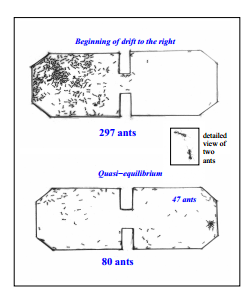First Physics-Like Experiments For Measuring Group Behaviour of Living Creatures
Chemists often use a standard argument to explain or predict the bulk properties of their creations. For example, it’s easy to predict that a liquid consisting of molecules that interact strongly will have a lower vapour pressure than one comprised of molecules that interact weakly.

The key, of course, is the strength of the interaction. Once known it can be used to predict a wide range of phenomenon.
At least, that’s the way chemists and physicists do it. Now Zengru Di, at Beijing Normal University in China, and Bertrand Roehner, at the University Pierre and Marie Curie in Paris, ask whether a similar approach might work for biological systems that consists of large numbers of similar entities; swarms of ants, fruit flies beetles and so on. They point out that knowing the strength of the interaction between creatures might lead to predictions about their group behaviour.
But there’s a problem–biologists have never measured the strength of the interaction between these creatures (or any others for that matter). So today Zengru and Roehner reveal their experimental method for measuring this interaction and show how it leads immediately to some interesting insights into behaviour.
The experiments are more or less straight out of a physics textbook. Take a box divided into two parts; fill one part with ants and then remove the dividing wall. The experiment consists of measuring the number and speed of the creatures that move into the empty part of the box. In essence, this is a kind of ideal gas experiment.
Zengru and Roehner think about two scenarios. If the movement of the ants is completely correlated, then if one ant moves from one side of the partition to the other, all the ants will follow.
If their movement is entirely independent, then the movement of one ant across the divide will not influence the behaviour of any of the others. Of course, some will cross of their own accord but the rate at which this happens will follow a standard distribution with a precise mathematical pattern.
Anything between these extremes will be an indication of the strength of the interaction between individuals in this species. And by repeating the experiments with different numbers of individuals, they say they can explore the nature of the interaction between them
That’s the theory anyway. In practice, Zengru and Roehner come across a number of obstacles. For example, when the density of ants is high, they tend to crawl on top of each other making it hard to monitor their individual motion. They’re hoping to overcome this by weighing the two parts of the box.
Nevertheless, Zengru and Roehner have some interesting results. They say the data indicates that the strength of the interaction between individuals does not depend on the distance between them, at least over scales of a few centimetres. “The experimental results clearly exclude an Ising-like interaction, that is to say one that would be restricted to nearest neighbors,” they say.
What’s more, whereas there is a mild attractive interaction between ants and beetles, the correlation between fruit flies is negative. Fruit flies repel each other, at least mildly.
Those are interesting insights from simple science. The idea of using “physics-like” experiments to measure the group behaviour of living creatures is clearly an interesting one.
There’s no shortage of computer simulations that attempt to model the group behaviour of various kinds of creatures. These models have varying levels of success but their link with experimental work has always been tenuous.
it’s just possible that Zengru and Roehner’s work could be the start of an experimental tradition that can complement the theoretical and observational work as well as the computer simulations. The study of the group behaviour of living organisms may never be the same.
Ref: arxiv.org/abs/1212.6349: Extending Physical Chemistry to Populations of Living Organisms. First step: Measuring Coupling Strength
Keep Reading
Most Popular
Large language models can do jaw-dropping things. But nobody knows exactly why.
And that's a problem. Figuring it out is one of the biggest scientific puzzles of our time and a crucial step towards controlling more powerful future models.
The problem with plug-in hybrids? Their drivers.
Plug-in hybrids are often sold as a transition to EVs, but new data from Europe shows we’re still underestimating the emissions they produce.
Google DeepMind’s new generative model makes Super Mario–like games from scratch
Genie learns how to control games by watching hours and hours of video. It could help train next-gen robots too.
How scientists traced a mysterious covid case back to six toilets
When wastewater surveillance turns into a hunt for a single infected individual, the ethics get tricky.
Stay connected
Get the latest updates from
MIT Technology Review
Discover special offers, top stories, upcoming events, and more.